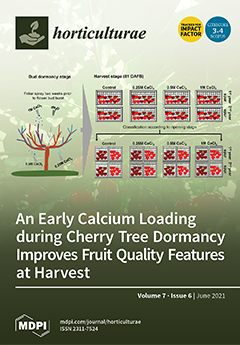Sulphurous acid derived from sulfur dioxide (SO
2) emission leads to the pollution of irrigation water and the inhibition of plant growth. The safe concentration threshold of NaHSO
3 in plants should be clarified to promote agricultural production. In this study,
Orychophragmus
[...] Read more.
Sulphurous acid derived from sulfur dioxide (SO
2) emission leads to the pollution of irrigation water and the inhibition of plant growth. The safe concentration threshold of NaHSO
3 in plants should be clarified to promote agricultural production. In this study,
Orychophragmus violaceus seedlings were used as experimental materials and five NaHSO
3 concentrations (i.e., 0, 1, 2, 5, 10 mmol·L
−1) were simultaneously sprayed on the leaf surface of different seedlings separately. Leaf physiology responses under different concentrations were analyzed. The NaHSO
3 did not promote photosynthesis in
O. violaceus under the 1 and 2 mmol·L
−1 treatments. It was conducive to the net photosynthetic rate (
PN), photorespiration rate (
Rp), chlorophyll content, actual photochemical quantum yield (Y
II) and photochemical quenching (qP) under the 5 mmol·L
−1 treatment. However, quantum yield of regulated energy dissipation (Y
NPQ) and nonphotochemical quenching (NPQ) were inhibited. Under the 10 mmol·L
−1 treatment,
PN, chlorophyll content, Y
II, qP, dark respiration rate (
Rd) and electron transport rate (ETR) showed significant decreases, while the photorespiration portion (
Sp) significantly increased. Our results demonstrated that NaHSO
3 provided a sulfur source for plant growth and interfered with the redox reaction of the plant itself, and its role as a photorespiratory inhibitor might be masked.
Full article





